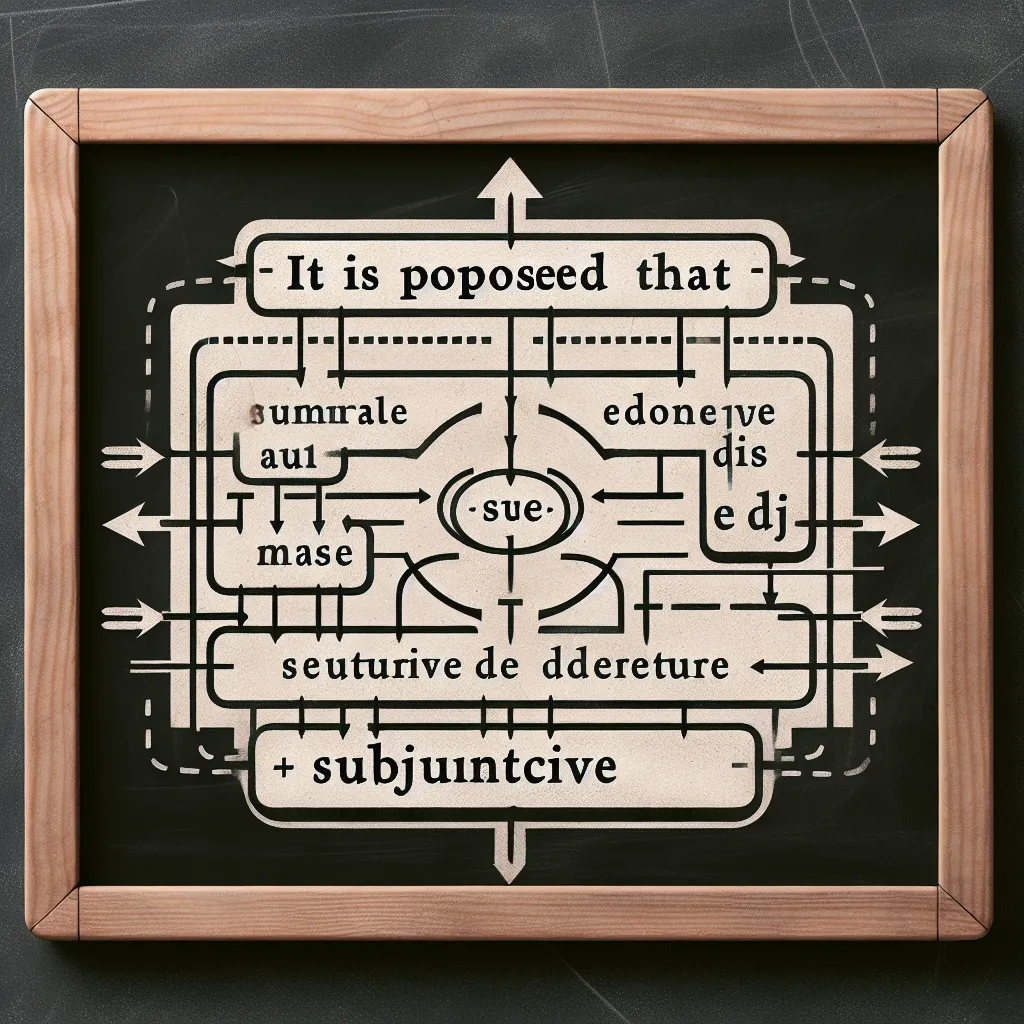The “It is proposed that + subjunctive” structure is a sophisticated grammatical construction that often appears in academic and formal writing, including IELTS exam tasks. Mastering this structure can significantly enhance your language proficiency and help you achieve a higher band score in the IELTS test. Let’s delve into the intricacies of this structure and explore how to use it effectively in your IELTS preparation.
Understanding the “It is proposed that + subjunctive” Structure
The “It is proposed that + subjunctive” structure is used to express formal suggestions or recommendations. It’s particularly common in academic, business, and legal contexts, making it highly relevant for IELTS Writing Task 2 and Speaking Part 3, where candidates are often required to discuss solutions to problems or suggest policies.
Formula and Grammatical Analysis
The basic formula for this structure is:
It is proposed that + subject + base form of verb
Let’s break down this structure:
- “It is proposed that” is an impersonal passive construction.
- The subject follows “that”.
- The verb after the subject is in its base form (subjunctive mood), regardless of the subject.

Examples and Applications in IELTS
Let’s examine some examples of how this structure can be used in different IELTS contexts:
-
IELTS Writing Task 2 (Problem-Solution Essay):
“To address the issue of urban congestion, it is proposed that governments invest more in public transportation systems.” -
IELTS Speaking Part 3 (Discussing Solutions):
“To improve air quality in cities, it is proposed that stricter emission standards be implemented for vehicles.” -
IELTS Writing Task 2 (Advantages and Disadvantages Essay):
“While online education offers flexibility, it is proposed that traditional classroom settings remain an essential part of the education system.” -
IELTS Speaking Part 3 (Speculating about Future Trends):
“Given the rapid advancement of technology, it is proposed that schools integrate more digital learning tools into their curricula.” -
IELTS Writing Task 2 (Opinion Essay):
“To combat rising obesity rates, it is proposed that a tax on sugary drinks be introduced in all countries.”
In each of these examples, the structure is used to formally present a suggestion or recommendation, which is particularly useful when discussing solutions to problems or proposing policies – common themes in IELTS tasks.
Using the Structure to Achieve Higher Band Scores
To achieve higher band scores in IELTS, it’s crucial to demonstrate a range of grammatical structures, including complex ones like “It is proposed that + subjunctive”. Here’s how using this structure can impact your score:
-
Band 6: Basic use of the structure, possibly with some errors.
Example: “It is proposed that the government should invest in education.” (Incorrect use of ‘should’) -
Band 7: Correct use of the structure with some flexibility.
Example: “It is proposed that the government invest more in education to improve literacy rates.” -
Band 8-9: Sophisticated and error-free use of the structure, often combined with other complex elements.
Example: “To address the widening skills gap in the technology sector, it is proposed that educational institutions collaborate more closely with industry leaders, ensuring that curricula remain relevant and up-to-date.”
Common Mistakes and How to Avoid Them
-
Using ‘should’ after ‘that’:
Incorrect: “It is proposed that the company should increase its budget.”
Correct: “It is proposed that the company increase its budget.” -
Using the wrong verb form:
Incorrect: “It is proposed that the government increases taxes.”
Correct: “It is proposed that the government increase taxes.” -
Forgetting to use ‘that’:
Incorrect: “It is proposed the city build more parks.”
Correct: “It is proposed that the city build more parks.” -
Using personal subjects:
Less formal: “I propose that we adopt a new strategy.”
More formal: “It is proposed that a new strategy be adopted.” -
Overusing the structure:
While it’s a useful structure, overuse can make your writing sound repetitive. Vary your language by using other structures as well.
Alternatives and Related Structures
To further enhance your language flexibility, consider these related structures:
- “It is suggested that…”
- “It is recommended that…”
- “It is advised that…”
These alternatives function similarly to “It is proposed that” and can help you vary your language while maintaining a formal tone.
Conclusion
Mastering the “It is proposed that + subjunctive” structure can significantly enhance your performance in the IELTS exam, particularly in Writing Task 2 and Speaking Part 3. By using this structure correctly and appropriately, you demonstrate a high level of grammatical control and formal language use, which are key criteria for achieving higher band scores.
Remember to practice using this structure in context, perhaps by writing sample essays or preparing speaking responses on topics like urban development, education reform, or environmental policies – all common themes in IELTS tasks where this structure would be particularly apt.
For further practice, try incorporating this structure into your responses to practice questions such as:
- How can governments address the issue of affordable housing in cities?
- What measures can be taken to improve the quality of public education?
- How should countries deal with the challenges of an aging population?
By mastering structures like “It is proposed that + subjunctive”, you’ll be well-equipped to tackle a wide range of IELTS tasks with confidence and sophistication.